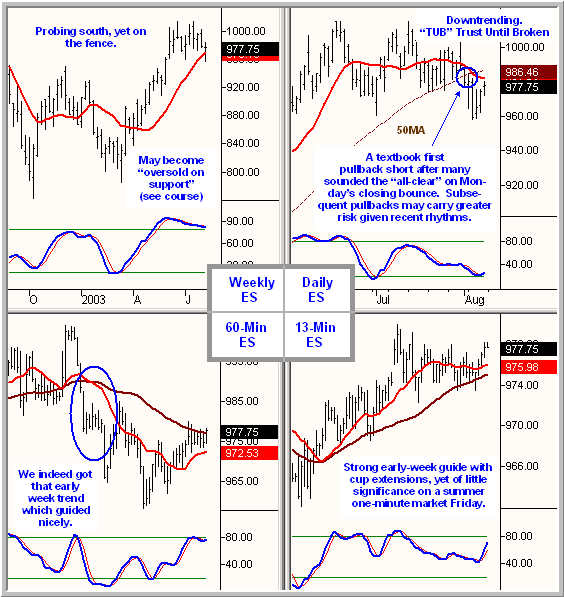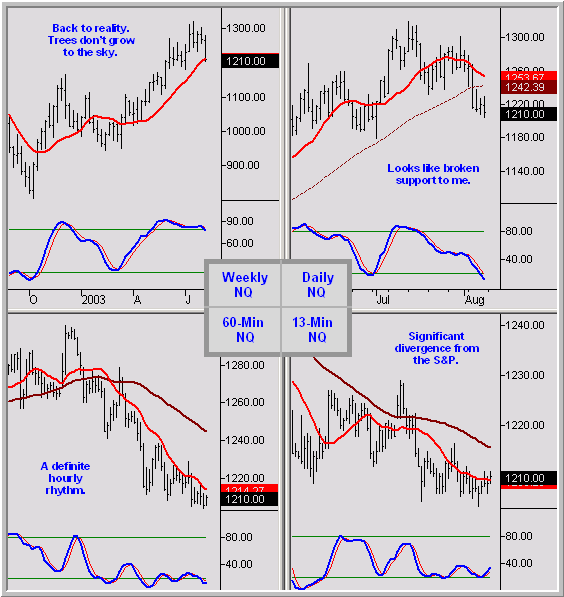Trading And Athletic Performance
Major markets closed mixed this
week, with the Nasdaq finally matching
the S&P in declining from overbought lofty heights, much to the chagrin of the
“gotta buy now” technology crowd that has been all but ignoring the
recent air pocket gap between Wile E. Nasdaq’s weekly price and the first hint
of ground (anvil courtesy of CSCO which actually missed its cash flow
forecast earlier in the week).
For the week, the S&P and Nasdaq markets closed down 2 and 58 points
respectively, with Friday’s S&P reflecting a chopfest market that seemed forever
torn between strong financials and an utterly pathetic performance in the
semiconductors. As such, Friday’s trading was pretty much left to one-minute
S&P E-Mini scalpers and longer-timeframe Nasdaq trend traders.
In bridging
last week’s column and charts with this week’s closing charts below, the
index action played out pretty much according to probability with the Nasdaq
again retracing to some sense of normalcy, while the S&P indeed put in a strong
tradable hourly trend early in the week after having chopped around in prior
sessions.Â
And continuing last week’s “first pullback” theme, despite the week-long S&P
range, there were ample tradable first pullbacks on numerous timeframes,
including a textbook short opportunity on day two (Tuesday) of the S&P’s 50MA
break. You may recall that was the morning when the press seemed to signal the
“whew, all’s OK” alarm — typical for those missing the concept of “new
resistance” from which to consider a low-risk short with a tight stop. Frankly,
it doesn’t get much better than that.Â
And thank goodness for first pullbacks in a market where follow-through
continues to be difficult in these dog days of summer, at least on the
S&P. Let’s again let the charts speak their piece, and then dive into a key
concept which may be of interest to struggling or slumping traders.
S&P 500

Nasdaq 100

Moving Avg Legend:Â
15MAÂ Â Larger
Timeframe 15MA
See https://www.donmillertrading.com
for Setups and Methodologies
Charts © 2003 Tradestation
“Not Yet”
When I traveled to New York earlier this year to speak at the Online Trading
Expo, I recall turning to ESPN Classic on the night when I arrived. During that
weekend, ESPN was airing various segments highlighting significant Michigan
sports moments, and on that particular night they were airing a segment on the
Detroit Pistons of the 1980s.
Of course, being an avid Celtics fan since my youth (in the classier pre-tattoo
NBA days), I was interested in watching to see if they would air highlights of
Game 5 of the 1987 Eastern Conference Finals — which as many NBA fans will know
was the game where all Isaiah Thomas had to do was to inbound the ball under his
own basket and run out the clock to seal the game and hand the Celtics a
devastating blow. Instead, Larry Bird made that now-famous incredible steal,
passed to Dennis Johnson for a lay-up, and the Celtics pulled out a miracle
finish. (Note to Piston fans, that’s OK, I have to live with Bill Buckner
visions at this end.)
Anyway, I continued watching the segment even after seeing that highlight which
had the interesting effect of (1) increasing my respect for that Detroit Pistons
team exponentially, and (2) reinforcing my long-standing beliefs that there is
absolutely no difference between effective trading and championship athletic
performance.
Specifically, the ESPN segment (and later, history) would go on to show that on
a longer term basis, the Pistons hadn’t “failed” at all. Rather both the
organization and players were simply in the process of learning something — in
this case a very hard “something” — that they needed to learn in order to take
that next step of truly becoming a championship team in the likes of the
extremely successful Celtics and Lakers of that era.Â
As interviews would show, one strong component of that necessary growth was the
development of a mental mindset that would allow the team to overcome the 1987
debacle, as well as any similar obstacle that would stand in their way. And the
team would face yet another serious mental challenge the following year, when
they lost to the Lakers in the pivotal Game 7 of the NBA Finals, a game in which
Isaiah was hobbled with a severely sprained ankle. One step forward, 1/2 step
back. Yet Detroit would then go on to win consecutive titles the following two
years.
OK, what’s this have to do with trading? Plenty. As you can probably imagine,
the parallels between the Pistons’ journey and that of working to become a
successful trader are incredibly strong, especially for those traders that feel
they are “so close” to crossing the threshold over to consistent
success. Whether you’re an apprentice, scratch trader, or one who has had past
successes yet is currently in a funk or simply spinning wheels, I would suggest
you close your eyes for a few moments (after you’re done reading the column
of course) and put yourself in Isaiah’s shoes just after the 1987 and 1988
seasons.
Imagine being “so close” to the championship — a reward that you spent entire
professional life pursuing –Â that you could see it and taste it, yet then
twice in successive years had it yanked away at the last moment, and then having
to explain the result to friends and fans over two long summers. The feeling may
seem very familiar.
For years, the Pistons were told they were “too young”, “too emotional”, “too
weak mentally”, and would never succeed against the “established
powerhouses”. They simply didn’t have what it took.
Fine. To such critics, which actually included me at the time, I would simply
add one word to that last sentence … “yet“.Â
As in, “they didn’t have what it took …
yet“.Â
You see, It’s amazing how such a simple three letter word can turn a troubled
and/or struggling mindset into one that is optimistic and success-oriented.
“Can’t” and “not” become “can’t yet” and “not yet”. Powerful.
I remember struggling recently in a trading funk and finally broke out of it, in
part, by not forcing the issue, in terms of setting my own timetable and simply
let it happen when it happened. Pretty tough for a control freak, yet in turning
the end-of-day answers to my own “did you break out of it?” mental exercise from
“no” to “not yet”, it seemed to put me in a frame of mind eager to approach the
next day knowing that I was very close and that tomorrow could be the day.
Over time, the intraday reads improved, followed by better synchronization of
executions with the reads (a key link that non-trading journalists will never
likely understand). Yes, it was slower than I would have liked (remember I can
often have the patience of a scalper), yet the “not yet” attitude seemed
to help.
Chris Curran’s Course
Lastly, you may be interested in checking out Chris Curran’s new course on
trading the Minis, which expands on a method we briefly touched on in our QQQ
and
E-Mini video and
seminars. It’s
a good supplement to our course reversal triggers which you may find highly
beneficial. (I have no financial interest in promoting the course … I simply
want traders to have the best education, regardless of whether it benefits me or
not.)
Good Trading and Have
a Great Weekend!
